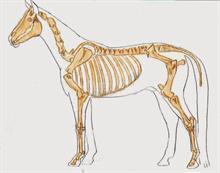The Horses Musculoskeletal System
The muscular system is made up of the striated muscles, skeleton together with the skeletons connective tissues, joints, and cartilage. The skeleton is held together by bands and ligaments that form anchors and levers for the muscles. The tendons are composed of thousands of collagenous threads that feed good circulation and many nutrients for it to work.
The skeleton of an adult horse is made up of 205 bones and a lot of cartilage. The skeleton has both a supporting function and keeps a reserve of calcium and phosphorous. A part of the bone, the bone marrow, creates red and white blood cells. Bones are an elastically living tissue, which are broken down and built up during the life of an organism.
During exercise, the form and quality of the bones adapt to the demands that are required. This happens in adult horses as well. It takes longer time to train the bones than muscles. That is why the bone tissue is very sensitive to overtraining, especially in growing foals.
Joints are the agile anchors for the skeleton. They give both stability and agility. Where the skeleton meets in pivot holes, the bone is covered in joint cartilage and imbedded in the joint capsule. The joint capsules outermost parts are made up of collagenous threads.
Joint cartilage is absent of nerves and blood vessels. That is why it gets all its nutrients from the synovial fluid inside the joint capsule. The synovial fluid supplies the joint cartilage with nutrients and prevents infection. It also lubricates the joints during motion.
In healthy joints, friction is less than between an ice skate and ice, only a tenth of what can be achieved with ball-bearings and butter.
The horse’s front legs are connected to the upper body with only muscles and tendons. The horse does not have a collarbone, which means the muscle tissue serves as ”shock absorbers”. The shoulder blade lies somewhere between the side of the body in the shoulder of the front leg and contributes to lengthening the step and making motions more elastic.
If muscles are tense due to poor blood circulation or inflammatorily processes, the horse will more easily be affected by strains on the skeleton. The back legs are propulsive, and at the point where the bone sticks out from the body a knee joint and knee cap imbedded in strong muscles can be found. From the hock joint and downwards, like in the front leg, tendons and ligaments are found that help good circulation.
In connection to joints, and even other places, there are bursa. They decrease the friction between muscles and bone. A bursa can stand in connection to the joint socket through a pathway, or be independent. The bursa is composed of a connective tissue capsule that has a fluid that is similar to the synovial fluid. The bursas size vary. The smallest are microscopic whilst the largest have a diameter of several centimetres. Inflammation in one of the bursa can give bursa a symptom, like a joint inflammation. When it gets inflamed it increases in volume and exerts a lot of pain.
The horse’s muscles are well developed and adapted for quick movement. Muscles are grouped together at the top of the leg and transition into tendons and ligaments from the carpal down to the hock joint. The skeletal muscles are composed of muscle fibres and connective tissue. Muscles work in pairs. Every muscle has an antagonistic counterpart. When a muscle contracts, the antagonist relaxes. These contractions and relaxation bend the joint and produce motion.
KEEP THE HORSES MUSCULOSKELETAL SYSTEM HEALTHY
It is usual for horses that train and compete to get frequent injuries due to acidification with effect on muscles, joints, ligaments, and tendons due to inflammatorily processes occurring. An acidic body can also create deposits of calcium from the skeleton which can cause strains on the vertebrae. Many competitive horses break bones due to decalcification. Poor blood flow can also happen, which minimizes build-up of synovial fluid and the joints get dry.
GLUCOSAFOR, MSM, ROSEHIPS AND PÄLSoHOV supports a healthy muscular and skeleton system in the horse.
The Skeleton

The skeleton of an adult horse is made up of 205 bones
The Muscles
 The horse has about 700 muscles and its task is to change the angles between two skeletal parts through contraction and relaxation.
The horse has about 700 muscles and its task is to change the angles between two skeletal parts through contraction and relaxation.
Shoulder blade bursae
 Joint, cartilage, bursae (blue) and skeletal muscle
Joint, cartilage, bursae (blue) and skeletal muscle

